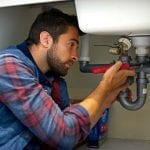Winter has arrived, and so have the freezing temperatures that accompany this time of year. While we’re all bundling up and trying to stay warm, your home is putting up a fight against the outside elements. Ice cold temperatures can wreak havoc on your home, especially on your pipes. In fact, the damage from frozen pipes is bad enough that it is the most common homeowner insurance claim. Though frozen pipes can cause extensive damage, the problem can be avoided with proper care.
Let’s see what you can do to prevent frozen pipes.
The easiest way: dripping faucets
One of the best ways to prevent your pipes from freezing is totally free and requires minimal effort: allowing your faucets to drip. We suggest only allowing one faucet to drip at a time, specifically the faucet that is furthest away from your water source. By making your water travel further, you can ensure that there is a lower chance of your pipes freezing since water is moving actively through it. If the temperature is going to be below 20 degrees Fahrenheit, we suggest allowing your faucets to drip.
What else can I do?
While letting your faucets drip is one of the easiest and cheapest ways to prevent your pipes from freezing, you may need some extra care to make sure that your pipes stay out of danger. If you need to keep your pipes from freezing, check out these tips:
- Add insulation. If you have pipes that run through the walls of your attic or basement, insulating those areas can help keep them warmer. The better you insulate your home, the less likely you’ll have to deal with broken, frozen pipes.
- Don’t change that dial. It’s tempting to want to save a few dollars by turning the thermostat down at night, but try to avoid it at all costs. Lowering your thermostat even a few degrees can increase the likelihood that your pipes can freeze, especially at night when it cools down. We suggest keeping your thermostat at the same, consistent temperature every day during the winter to prevent any issues.
- Keep the heat running while you’re gone. If you’re taking a vacation in the winter, don’t turn off your heat entirely. You don’t have to keep your home at 80 degrees by any means, but do not turn your thermostat any lower than 55 degrees. After all, you really don’t want to spoil a vacation by coming home to a burst pipe.
- Keep the pipes warm. There are some methods you can use to insulate the pipes themselves to help prevent freezing. Pipe insulation can be cheap and easy to apply, or you can use heat tape to help insulate. Whichever method you choose, be sure to be careful that you apply it correctly.
What can I do once my pipes are frozen?
Sometimes, despite our best efforts, our pipes can still freeze. A frozen pipe isn’t the end of the world – if you can thaw it quickly and safely, you can avoid a costly burst pipe. A frozen pipe is usually very easy to notice since it will be covered in ice, but if your pipes are inside the walls it may not be so obvious. If you turn on your faucet and no water comes out after a cold snap, that can also be a sign of a frozen pipe.
Once you suspect a frozen pipe, be careful about your next steps. Use tools like hair dryers, space heaters, heating pads or hot water to help the pipe thaw. Under no circumstances should you ever use an open flame, as this can weaken or break your pipes. If you cannot locate the pipe, we suggest contacting a plumber to help you identify the source of the ice blockage.
If your pipe does burst, you should immediately shut off the water supply to limit the damage done to your home. Your next two calls should be to a plumber and your insurance agent or landlord, as burst pipes must be fixed immediately to avoid major water damages.
Need plumbing help fast? Contact Elite Renovations at 417-708-8393 for expert services when you need them most.





